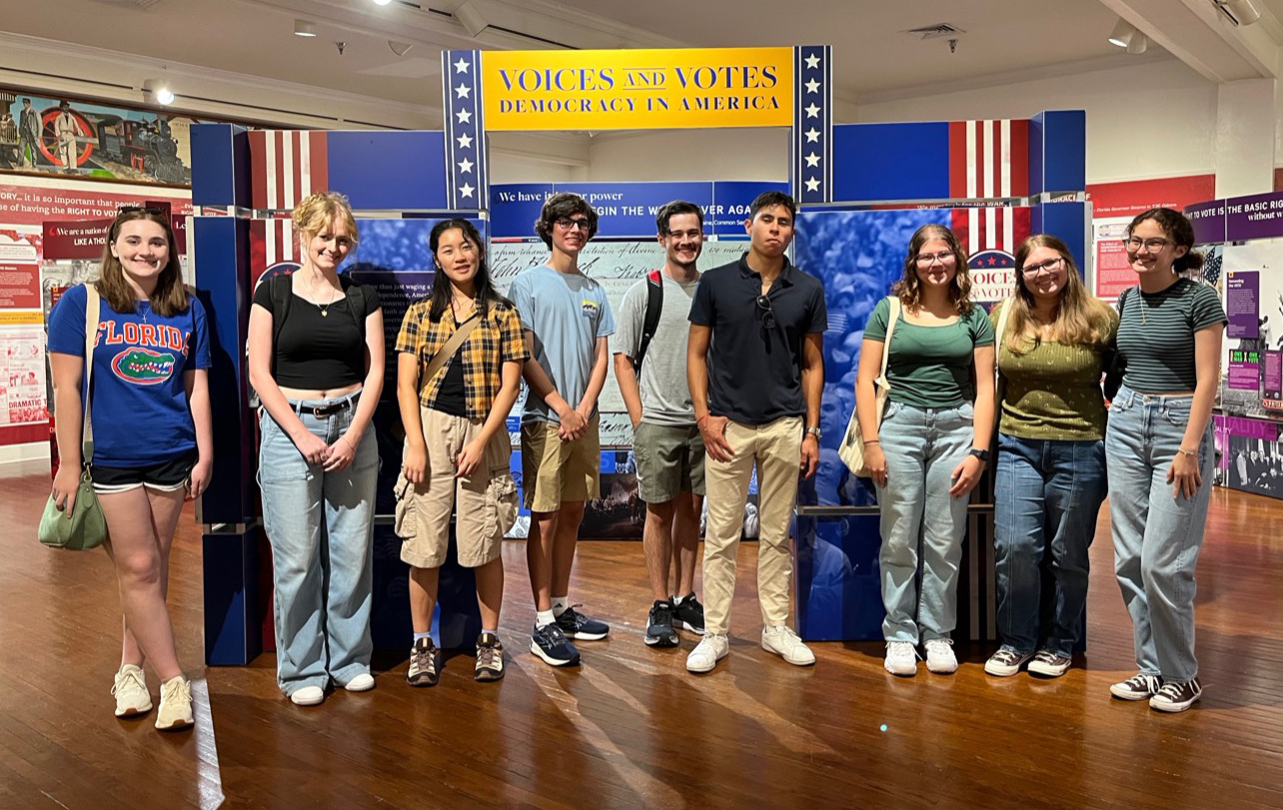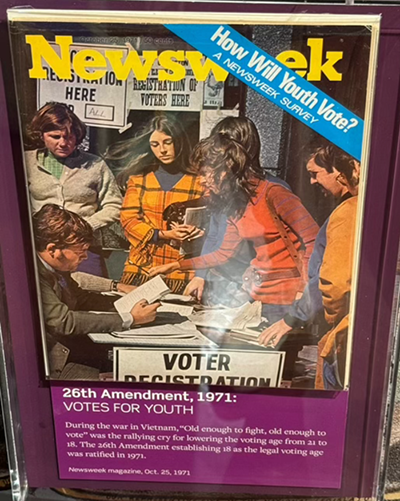The students of the class Democracy in Theory and Action had a tour of the very timely and well-curated exhibition of Matheson Museum of Gainesville entitled ‘Democracy in America’ (August 2024). This visit was part of the experiential learning activities this class offers to undergraduate students from extremely diverse academic backgrounds. This proved to be an excellent learning opportunity for the class who learned more about democratic theory and democratic practice, which lie in the heart of the course. Select student responses to the value of this exhibition as a learning opportunity and briefly discussing the exhibit that helped them better understand democracy are shared below. We would like to express our gratitude to the Matheson museum staff for this experiential learning opportunity for our class!
— Dr. Ifigeneia Giannadaki, Associate Professor in Classics and Casas Chair in Greek Studies, UF

Democracy in America through the Students’ Voices
Ava:

The exhibit I found the most interesting was about lowering the voting age to eighteen through the 26th Amendment. This amendment emerged from the times of the Vietnam War when the minimum age to be drafted was eighteen. Therefore, as stated in the exhibit, young people at the time felt that they were “Old enough to fight, old enough to vote”, meaning that if they were taking on the responsibility of participating in war, they should also be granted a voice in government. As this year’s election may be the first election most of us have ever voted in, it is important to look back on the history of the vote. Some may take it for granted when, in truth, voting at the age of eighteen only started about 50 years ago. This exhibit, therefore, sheds light on the crucial work done to gain the vote for the younger population while offering young adults an appreciation for the weight of their vote when filling out their ballot. Only in recent times has the voices of the young population been truly expanded.
Natalie:
Of all the subsections of the main exhibit: “Voices and Votes: Democracy in America,” the most impactful to me, was the section dedicated to women’s suffrage. When put into perspective, it was really not that long ago that women were granted the right to vote in America, which helped me understand that maybe the American democracy is/was not always by the people, for the people, especially when an important group of people were not allowed to participate. Reading some of the details on the subject in the infographic truly made me grateful that I will be able to vote in this upcoming election. This museum trip also highlighted the importance of having exhibitions and public space, as they provide easily accessible information to the masses, who may come out of the experience influenced to contribute to their civil duties (such as voting). Museums also provide an insight into history, which is important to take into account when making decisions today, as to not let history repeat itself and damage all the progress we as a country have made.
Sebastian:

In a museum about democracy, one display in particular stood out to me. It was a wall covered in protest signs with simple, catchy slogans. What struck me most about the display was the wide range of topics from BLM to Nuclear Disarmament. This got me thinking about the importance of protesting in democracy. Because in American democracy, the people do not directly choose policy, so protests are important to demonstrate to the government the will of the people. This can be seen in many instances, for example, the 504 protests, which were a series of protests aimed at expanding the civil rights of disabled people. The 504 protests were successful, demonstrating how protests allow citizens of all walks of life to be heard. After a protest ends, successful or not, it is important to remember the work of the protestors so it may carry on past them. It is for this reason that Museums hold a vital role in the democratic process, as not only do they allow us to look back on how far we have come, but they also preserve the knowledge of past protests, allowing for their messages to live on and inspire the next generation.
Brooks:

The most impactful of the exhibits I visited focused on American democracy between 1888-1940, examining the voter suppression and disenfranchisement black people faced, even though they had technically gained the right to vote and participate in American democracy. It demonstrated exactly how democracy is not immune to abuse by majority groups against minorities. While African Americans became citizens and could vote after the Reconstruction amendments, white people in power imposed poll taxes, unreasonable literacy tests, and often physically intimidated Black people from participating in democracy. A vicious cycle arose in which Black people could not advocate for themselves by participating in government, allowing politicians to pass discriminatory laws to further uphold segregation and systemic racism. As we’ve learned in class, one of the fundamental ideals of democracy, both Athenian and modern, is equality under the law. In practice, however, that equality is only achieved with the consent of the majority.